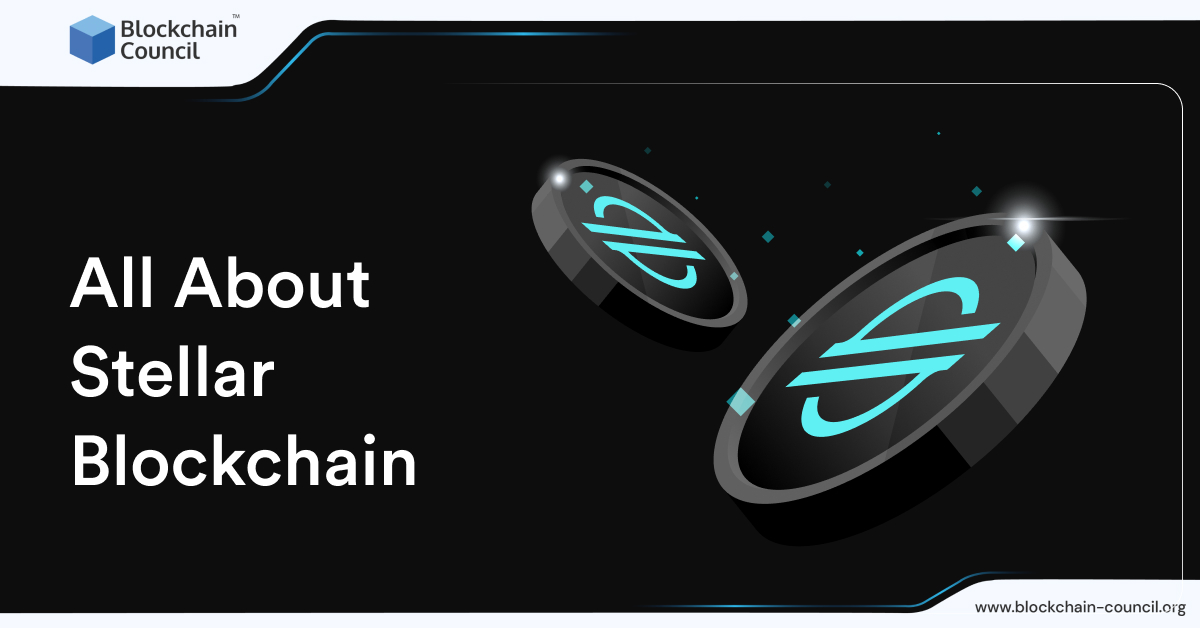
- Blockchain Council
- May 08, 2023
Summary:
- Stellar is a decentralized Blockchain network that aims to facilitate cross-border payments and asset transfers.
- Stellar was created in 2014 by Jed McCaleb, one of the co-founders of Ripple.
- Stellar uses its own native cryptocurrency called Lumens (XLM) which serves as a bridge currency for cross-border payments.
- Stellar's consensus algorithm is called the Stellar Consensus Protocol (SCP), which is designed to be fast, energy-efficient, and secure.
- Stellar's network has a built-in decentralized exchange that allows users to trade various assets, including fiat currencies and cryptocurrencies.
- Stellar has a partnership with IBM and other companies to provide cross-border payment solutions for financial institutions and businesses.
- Stellar also has a non-profit organization called the Stellar Development Foundation, which is focused on promoting financial inclusion and providing education and resources for developers to build on the Stellar network.
- Some of the key advantages of using Stellar include low transaction fees, fast transaction times, and the ability to facilitate cross-border payments with various currencies.
Over time, Blockchain has emerged as one of the most talked about topics, from its importance in building secure and efficient applications to creating a decentralized internet; Stellar is part of that same initiative that strives to create a better Blockchain service and is more flexible than its competitors. Stellar Blockchain is a decentralized network that facilitates cross-border payments, tokenization of assets, and other financial transactions. It was created in 2014 by Jed McCaleb. Notably, he also co-founded Ripple. Stellar aims to make financial services more accessible and affordable for everyone by leveraging Blockchain technology.
Stellar is important for Blockchain enterprises because of its functionalities, like chain support and cross-border payments. In this blog, we will dive deep into all aspects of Stellar Blockchain, from how it works to its advantages, use cases, challenges, and future outlook. We will also discuss how knowing about Stellar is crucial for aspiring developers.
How Stellar Blockchain Works
Unlike other forms of verifications like proof of work(PoW) or proof of stake(PoS), Stellar uses a consensus algorithm that their native organization has developed, called the Stellar Consensus Protocol (SCP), to validate transactions on the network. SCP is designed to be fast, secure, and energy-efficient. Unlike Blockchains relying on proof-of-work or proof-of-stake, Stellar uses a unique federated Byzantine agreement (FBA) algorithm for fast and reliable transaction processing.
Stellar has its native cryptocurrency called Lumens (XLM), which is used to facilitate transactions on the network. XLM is designed to be a bridge currency that can convert between different fiat currencies or other cryptocurrencies. For example, if someone wants to send money from the US to Europe, they can use XLM to convert US dollars to euros and transfer them to the recipient.
History of Stellar Blockchain
To understand the objective and goals of Stellar properly, it is essential to take a brief look at its history and how it gained the reputation it holds with the different businesses operating in the market.
Partnership with IBM
In October 2017, Stellar announced a partnership with IBM to create a new Blockchain-based payment system. The partnership aims to create multiple currency corridors among South Pacific nations, including Australia, Fiji, and Tonga. The system would enable faster and more efficient cross-border payments, which is particularly important for small businesses and nonprofits that rely on these transactions to conduct their operations.
Benefits of the partnership
The partnership with IBM will significantly benefit the region. For example, small businesses can easily and cheaply transact with customers and suppliers in other countries. Nonprofits can receive donations from anywhere worldwide without worrying about high transaction fees or long waiting times. Local banking institutions can offer more services to their customers, including cross-border payments, which will help them to compete with larger banks.
Partnership with Deloitte
In addition to the partnership with IBM, Stellar has partnered with Deloitte to develop a payments app. The app allows businesses and individuals to send and receive payments in any currency, including digital currencies like Lumens. The app is expected to be fast, secure, and easy to use, making it an attractive option for cross-border business transactions.
30 banks on board
Stellar’s Blockchain technology has attracted the interest of many financial institutions. In 2017, Jed McCaleb confirmed that 30 banks had signed up to use Stellar’s Blockchain for cross-border transfers. These banks include major players such as the Bank of England, Credit Agricole, and Mitsubishi UFJ Financial Group. The fact that so many banks have expressed interest in Stellar’s technology is a testament to its potential to disrupt the traditional financial industry.
Become a Certified Blockchain Developer Today!
Stellar Blockchain vs. Ripple
It is not a hidden fact that Stellar is a hard fork of Ripple, which makes it very similar to it in terms of structure and limitations, but there are some major differences that we need to consider when we talk about Stellar and Ripple. The main difference is that a for-profit company owns Ripple, while a nonprofit organization called the Stellar Development Foundation runs Stellar. Additionally, Ripple mainly works with big banks and financial institutions, while Stellar focuses on helping people in developing countries.
Because Stellar is open-source, developers can create new applications and tools using its technology. This means many job opportunities are available for people skilled in programming and development. Some examples of jobs in this field include Blockchain developers, software engineers, and technical project managers.
Stellar is an exciting new technology that has the potential to make a big impact on the world of finance. Whether you’re a developer looking for a job or someone interested in learning more about cryptocurrencies, Stellar is worth watching.
Features of Stellar Blockchain
We will discuss some features that have facilitated Stellar’s growth and helped it emerge as a major player in the Blockchain finance industry.
Decentralization and Open-Source
The Stellar database is decentralized, meaning no single entity controls the network.
This allows for a transparent and trustworthy system, as every user can see the same information on the network. Being open-source, anyone can view, modify, or contribute to the code that powers the Stellar Blockchain. Decentralization and open-source features make the Stellar Blockchain ideal for businesses and organizations developing decentralized applications, smart contracts, and other innovative use cases.
Fast Transaction Confirmation Time
The Stellar consensus mechanism allows for quick confirmation of transactions, with a time frame of just 3 to 5 seconds. This means that payments and other transactions can be completed almost instantly, making Stellar a preferred platform for cross-border payments and remittances. The fast transaction time of Stellar Blockchain makes it a popular choice for companies and organizations that require quick and secure transactions, such as online retailers, financial institutions, and gaming platforms.
High Transaction Throughput
Stellar can support thousands of transactions per second, making it highly scalable and efficient. This makes it suitable for large-scale enterprise applications, where a high transaction throughput is critical. Stellar’s high transaction throughput makes it ideal for use in industries where there is a need for rapid and high-volume transactions, such as e-commerce, supply chain management, and logistics.
Multi-Signatures and Smart Contracts
Stellar supports multi-signatures and smart contracts, which can be used to execute complex transactions and automate processes. Smart contracts are self-executing programs that can facilitate and verify transactions without intermediaries. Multi-signatures and smart contracts make Stellar Blockchain an attractive platform for businesses that require secure, automated, and transparent processes, such as healthcare, insurance, and real estate.
Fixed Annual Inflation
Stellar has a fixed annual inflation rate of 1%, ensuring the network remains sustainable and secure. This incentivizes users to hold and use the Stellar cryptocurrency, as the fixed inflation rate reduces the likelihood of market manipulation and price volatility. Stellar’s fixed annual inflation rate provides stability and predictability, making it an attractive platform for businesses and investors looking to develop long-term, sustainable applications and use cases.
Understanding Stellar Blockchain Decentralized Structure
Stellar is a decentralized system that works peer-to-peer and operates without a central authority. It offers several components that make it a truly decentralized platform, including the ledger system, consensus protocol, and anchors.
The ledger system
Stellar uses an open and transparent Blockchain. All transactions on the Stellar network are stored on this ledger, which is open for everyone to view. This feature ensures transparency, and all users can see every transaction on the network.
Stellar consensus protocol
The Stellar consensus protocol is a key feature of the platform, ensuring that all network decisions are based on consensus. This process occurs every 3-5 seconds, allowing for a fast and efficient transaction confirmation time.
Anchors and credits
Anchors are essential in the Stellar architecture as they bridge the traditional banking system and the Stellar network. They hold deposits and issue credits, facilitating value movement into and out of the Stellar network. They are responsible for holding deposits for users and issuing credits to users. The Stellar network relies on Anchors to provide liquidity and enable the movement of assets across borders.
The role of Anchors in the Stellar network is vital to its success, enabling the platform to provide fast and efficient cross-border payments. The Anchors also provide job opportunities for developers, who can work on building custom solutions that integrate with the Stellar network. Rewrite this, adding appropriate subheadings.
The Native Token of Stellar
Stellar has a native token that is employed to support the functionalities it aims to offer. It helps to keep the network functioning smoothly by serving two main purposes. Lumens can prevent spam on the network by covering the transaction fees. Using Lumens helps ensure the network is not overloaded with too many transactions, which could slow down the network.
Lumens can be used as a bridge between different cryptocurrencies. This means that it enables faster transactions when two different cryptocurrencies are involved. Lumens can convert one currency to another, making it easier to conduct multi-currency transactions. There are around 100 billion Lumens in circulation with an annual inflation rate of 1%. This helps to maintain a consistent supply of Lumens on the network.
Advantages of Stellar Blockchain:
Stellar offers several advantages over traditional financial systems and Blockchains. Here are some key benefits:
Faster and Cheaper Transactions
Stellar can process thousands of transactions per second with minimal transaction fees, making it faster and cheaper than traditional payment methods. For example, a cross-border payment using traditional banking channels can take several days and cost up to 10% in fees. At the same time, a Stellar transaction can be completed within seconds and cost less than a penny.
Secure and Transparent
Stellar uses cryptography to secure transactions and keep user data private. All transactions on the network are recorded on a public ledger that can be audited by anyone, providing transparency and accountability.
Compatibility with Other Blockchains
Stellar is designed to be interoperable with other Blockchains, which means it can exchange assets with other networks. For example, Stellar can facilitate the transfer of Bitcoin, Ethereum, or any other Blockchain-based asset.
Decentralized and Trustworthy
Stellar is a decentralized network, meaning no single entity or organization does not control it. This makes it more trustworthy and resilient than centralized systems vulnerable to hacking or manipulation. This helps gain the trust of small business people in developing countries who distrust big corporations and see them as exploiting entities.
What makes stellar Blockchain unique and valuable?
Stellar’s decentralized exchange and inflation model are important features of the Blockchain platform, making it a unique and valuable player in the Blockchain industry.
Decentralized Exchange (DEX)
One main feature that sets Stellar apart from other Blockchain platforms is its decentralized exchange (DEX). The Stellar protocol enables users to exchange any token for any other token seamlessly and quickly, linking buyers and sellers directly. This eliminates the need for third-party intermediaries to manage settlement or hold custody of assets, making transactions faster, cheaper, and more secure. The decentralized nature of the DEX also ensures that the platform is resistant to hacks and centralized control, which is a significant concern for the Blockchain industry.
Inflation Model
Initially, Stellar had an inflation model with a 1% annual subsidy. However, the Stellar Development Foundation chose to eliminate the subsidy and increase the programmable supply in late 2019. The foundation also limited its part of the XLM supply to regulate the XLM economy. This move ensures that the value of the XLM token remains stable and prevents inflation from reducing its value. It also creates a predictable and stable environment for financial companies and other users to engage in transactions, making Stellar a reliable platform for cross-border payments.
Cross-Border Payments
Stellar’s decentralized exchange and fast transaction confirmation times make it an ideal platform for cross-border payments. Its open-source and cross-border APIs make it easy for financial companies and other users to integrate their services into the Stellar network without intermediaries or go-betweens. This feature is crucial for the Blockchain industry, where fast, secure, and cost-effective cross-border payments are in high demand.
Job Opportunities for Developers
Stellar’s decentralized nature and open-source codebase create opportunities for developers to work on building custom solutions that integrate with the Stellar network. The platform’s unique features, such as the decentralized exchange and inflation model, provide developers with a new playground for building innovative solutions that could disrupt the traditional financial industry. This creates job opportunities and drives innovation in the Blockchain industry.
Transactions on Stellar Blockchain
Stellar’s distributed exchange operates through three main types of transactions, each with unique features and benefits.
Indirect Transactions
Lumens (XLM) can facilitate indirect transactions on the Stellar network. In this process, the exchange finds individuals who want a specific currency in return for Lumens. For example, if a user wants to exchange USD with the Euro, the exchange would find someone who wants USD in return for Lumens. Once they complete the transaction for USD with Lumens, the user can find someone who wants it for Euro and complete the transaction. This process is useful when direct conversion is unavailable, or liquidity is low.
Peer-to-Peer Transactions
Peer-to-peer transactions involve the distributed exchange finding the right buyer/seller pair based on their desired currencies and the amount they want to exchange. The exchange follows the order book model and matches the offers to complete transactions. This approach enables users to find the best exchange rates and complete transactions quickly and efficiently.
Indirect Chain Conversion
Indirect chain conversion is complex when the other two types of transactions fail. It starts with exchanging USD for another currency, such as INR, which is converted into other currencies before finally converting into Euro. This process can take longer and may involve additional fees, but it is useful when direct conversions are unavailable or when liquidity could be higher.
Importance for Blockchain Industry
Stellar’s distributed exchange system demonstrates the power of decentralization and highlights the potential for Blockchain technology to disrupt traditional financial systems. By enabling peer-to-peer transactions and indirect conversions, the Stellar network eliminates the need for intermediaries and reduces the costs associated with traditional currency exchanges.
This opens up new possibilities for businesses and individuals looking to move money across borders quickly, cheaply, and securely. Stellar’s distributed exchange system represents a major innovation in the Blockchain industry, with potential applications that extend far beyond financial transactions.
If you are still someone who has yet to learn about Blockchain and its impact and are a passionate developer, try to learn about Blockchain and its underlying tech with considerable focus to increase your job perspectives in the market. It would help if you looked for a course that can help you learn everything from basics to advanced concepts in a curated way that experts in the field have prepared. Blockchain Council is one of the most revered certifications, and you should check our courses on Blockchain technology that will help you make an intelligent decision.
Use Cases of Stellar Blockchain
Stellar has several use cases demonstrating its potential to transform the financial industry. Here are some examples:
Cross-border Payments and Remittances
Stellar can facilitate cross-border payments and remittances, making it easier and cheaper for people to send money across borders. For example, companies like IBM use Stellar to create a global payment network connecting banks and financial institutions in different countries.
The Tokenization of Assets
Stellar can tokenize assets such as real estate, stocks, or commodities, making them more accessible and tradable. For example, a company can issue tokens on the Stellar network representing property ownership, allowing investors to buy and sell fractions of the property without going through a traditional broker.
Micropayments and Donations
Stellar can facilitate micropayments and donations, making it easier for people to support causes or content creators they care about. For example, a website can use Stellar to accept micropayments for articles, videos, or music. This is per the company’s objective to make it viable for small businesses and individuals.
Decentralized Exchanges (DEX)
Stellar can create decentralized exchanges (DEX) that allow users to trade cryptocurrencies without going through a centralized exchange. For example, a user can exchange Bitcoin for XLM on a DEX built on the Stellar network. We have already discussed the decentralized exchanges above, so if you have any doubts, please read them in more detail.
Challenges and Limitations
While Stellar Blockchain offers many benefits, some challenges and limitations must be addressed. Here are a few:
Scalability Issues
As more people use Stellar, there is a risk that the network could become congested, leading to slower transaction times and higher fees. To address this issue, Stellar is improving its infrastructure and scalability.
Competition with Other Blockchains
Stellar faces competition from other Blockchain networks that offer similar services, such as Ripple, Ethereum, and Bitcoin. To stay competitive, Stellar needs to continue innovating and improving its technology.
Centralization Risks
While Stellar is designed to be decentralized, there is a risk that a few powerful nodes could gain too much control over the network, leading to centralization. To prevent this, Stellar must ensure the network remains decentralized and democratic.
Concerns About Stellar Blockchain
Stellar’s launch was accompanied by investor concerns over the large number of lumens tokens controlled by the Stellar Development Foundation (SDF). Rather than creating new tokens through mining, the Stellar creators allocated 100 billion lumens tokens, with a majority being given to the SDF for development and adoption. However, investors were worried that the SDF might sell these tokens on the market, potentially reducing the value of other investors’ holdings. To address these concerns, the SDF intentionally destroyed 55 billion lumens tokens in 2019.
Another concern is that the Stellar network relies on a small number of nodes, many of which are controlled by the SDF. In 2019, two of these nodes failed unexpectedly. This caused the Stellar Blockchain to stop for over an hour. This incident highlighted the risks of centralization in Blockchain networks and the importance of ensuring decentralization to prevent single points of failure. The Stellar Development Foundation has since increased the number of nodes to reduce the likelihood of a similar occurrence in the future.
Future Outlook
Despite the challenges, the future looks bright for Stellar Blockchain. The network has already gained significant adoption in the financial industry, with companies like IBM, Deloitte, and Stripe using it for their payment systems. As more people become aware of the benefits of Blockchain technology, we expect to see more adoption of Stellar and other Blockchains in the coming years.
Stellar is also working on several improvements and developments, such as implementing a new protocol called StellarX, enabling users to trade a wider range of assets on the network. As traditional financial systems face challenges and limitations, we expect more integration between Stellar and traditional financial institutions. This could lead to a more efficient and accessible financial system for everyone.
Conclusion
Stellar Blockchain is a powerful technology that has the potential to revolutionize the financial industry. Its fast, secure, and affordable transaction processing and its interoperability with other Blockchains make it an attractive option for businesses and individuals.
Different small businesses in developing nations have already shown their interest in technology. With the growing demand, individuals with knowledge of Blockchain will also be in demand to fulfill the needs of these new businesses and enterprises. It would be best if you upskill yourself with the help of our course to take advantage of any upcoming opportunity.
Frequently Asked Questions
Stellar can handle up to 4,000 transactions per second (TPS) on its network, significantly faster than many other Blockchain platforms.
The average confirmation time for a Stellar Blockchain transaction is around 5 seconds, making it one of the fastest Blockchain platforms for processing transactions.
Stellar does not have full-fledged smart contracts, but it supports a simple form called “smart assets.” Smart assets are tokens representing any asset with specific conditions attached to them, such as transferring ownership or triggering certain actions.
Stellar runs on its Blockchain platform called the Stellar Consensus Protocol (SCP), a federated consensus mechanism designed for high throughput and low latency.
The Stellar network can handle up to 4,000 TPS, significantly higher than most Blockchain platforms. This high throughput is achieved through SCP, which allows for fast and efficient consensus among nodes.
Stellar has over 2,000 active nodes on its network, which are distributed across the globe and help maintain the Blockchain’s security and integrity. The decentralized nature of the network makes it highly resistant to attacks. It ensures the network can continue functioning even if some nodes go offline.



































































 Guides
Guides News
News Blockchain
Blockchain Cryptocurrency
& Digital Assets
Cryptocurrency
& Digital Assets Web3
Web3 Metaverse & NFTs
Metaverse & NFTs
